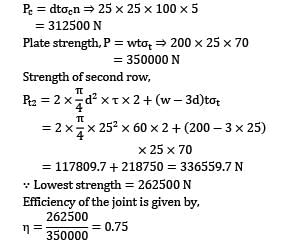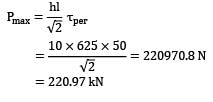Test: Design of Joints Level - 3 - Mechanical Engineering MCQ
20 Questions MCQ Test - Test: Design of Joints Level - 3
Assertion (A): Uniform-strength bolts are used for resisting impact loads.
Reason (R): The area of cross-section of the threaded and unthreaded parts is made equal
Two plates are joined together using two bolts as shown in figure. The shear strength in yield for the bolt material is N mm . Taking a factor of safety of 6, the diameter of the bolt is
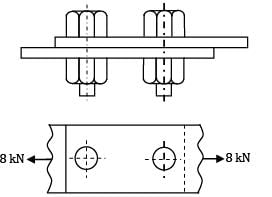



A circular shaft, 40 mm in diameter, is welded to the support by means of circumferential fillet weld. It is subjected to a torsional moment of 3000 Nm. Permissible shear stress in weld is limited to N mm . The size of weld is


A plate 50 mm wide and 10 mm thick is to be welded as T joint to another plate by means of two parallel fillet welds. If the plates are subjected to a static load of 78 kN and the allowable shear stress is 144 MPa. The weld length per side (in mm
A steel plate 200 mm wide and 5 mm thick is welded with another steel plate as shown in figure. The permissible tensile and shear stresses for the weld material are 80 MPa and 60 MPa respectively. If the plates can withstand a load upto 80 kN, then the ratio of the strength of transverse fillet weld to the double parallel fillet weld is __________

A bracket shown in the figure is bolted to a column using two bolts. If the permissible shear stress of the bolt material is 300 MPa, then the factor of safety is ( a ing d mm)
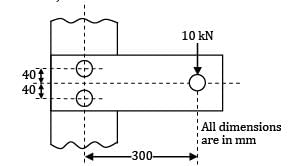
A riveted joint has been designed to support an eccentric load P. The load generates value of equal to 4 kN and equal to 3 kN. The cross-sectional area of each rivet is mm . Consider the following statements
1. The stress in the rivet is N mm
2. The value of eccentricity L is 100 mm
3. The value of load P is 6 kN
4. The resultant force in each rivet is 6 kN Which of these statements are correct?
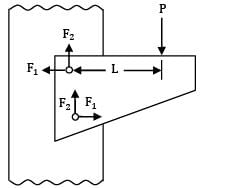
For the figure shown below, the permissible tensile and shear stresses for the weld material and plates are N mm and N mm . If the depth of weld is 15 mm, the length of each parallel fillet weld is

A bracket is welded to the vertical plate by means of two fillet welds as shown in figure. The stresses induced in the weld are

Two plates, 25 mm thick, are welded together by means of a reinforced butt weld and subjected to a completely reversed axial load of 土100kN as shown in figure. The throat of the weld is 25 mm. The ultimate tensile strength of the weld metal is 450N/mm2. The surface finish of the weld is equivalent to that of forged component and the reliability is 90%. The length of the weld is
[Assume factor of safety is 2.
![]()
![]()
A circular beam, 50 mm in diameter, is welded to a support by means of a fillet weld as shown in figure. The size of the weld, if the permissible shear stress in the weld is limited to 100N/mm2, is (in mm)

A bracket, as shown in figure, is welded to a plate. The welds are of same size
The value of permissible force per mm of the weld length is
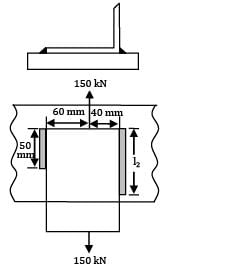
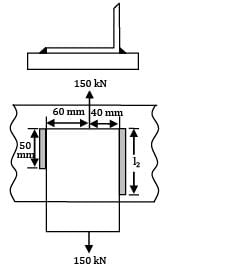
A bracket is welded to the vertical plate by means of two fillet welds as shown in the fig. If the permissible shear stress is limited to 55N/mm2 . The size of weld is __________ (mm)
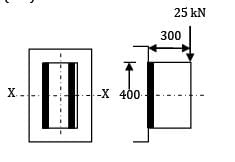
In the figure a plate is connected to another plate by fillet welds around the ends and also inside the machined slot. The working stresses for the transverse welds and longitudinal welds are. 102.5 MN/m2 and 84MN/m2 respectively. If joint is subjected to a pull of 100 kN, the size of weld will be
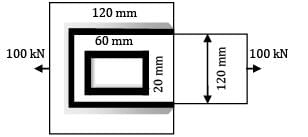
An mm angle is welded to a steel plate by means of fillet-welds as shown in the figure. The angle is subjected to a static load of 140 kN, which passes through the center of gravity G and the allowable load per mm of the weld length is 700 N. The length of the shorter fillet weld is
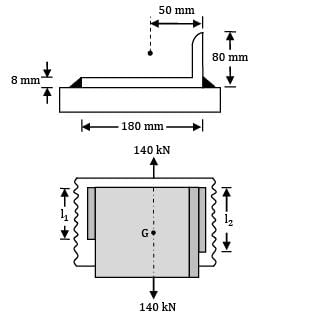
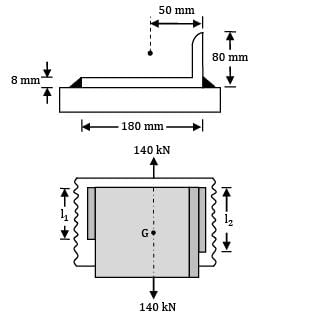
The following two figures show welded joints (x x x x x indicates welds), for the same load and same dimensions of plate and weld.
The joint shown in
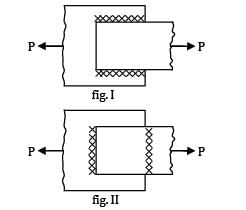
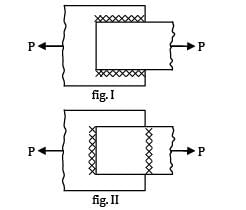
A plate 1 m long, 70 mm thick is welded to another plate at right angles to each other by 12 mm fillet weld, as shown in the figure. What is the maximum torque T, that the welded joint can sustain if the permissible shear stress intensity in the weld is not exceed to 80 MPa.
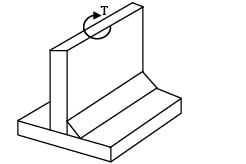
A cast iron bracket, supporting the transmission shaft and the belt pulley, is fixed to the steel structure by means of four bolts as shown in Fig. There are two bolts at
A and two bolts at
B. The tensions in slack and tight sides of the belt are 5 kN and 10 kN respectively. The belt tensions act in a vertically downward direction. The distances are as follows,
l1 = 50 mm, l2 = 150 mm, l = 200 mm The maximum permissible tensile stress in any bolt is 60 N/mm2 . Determine the size of the bolts (in mm2 )

Two flat plates subjected to a tensile force p are connected together by means of 25 mm diameter rivets with double strap butt joint as shown.
The thickness of plate is 25 mm and plate width is 200 mm. Rivets and plates are made of same material and having following properties.τper.= 60 MPa, (σt) = 70 MPa, (σc)per= 100 MPa What is the efficiency of the joint?
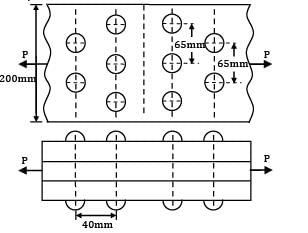
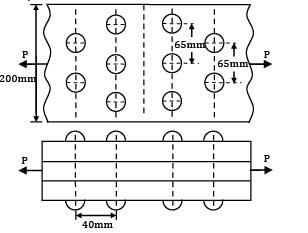
A steel plate is joined with another plate using weld fillet as shown in the figure. If the permissible shear stress of weld material is 50 N/mm2 and leg of the weld is 10 mm, what could be the maximum value of P?
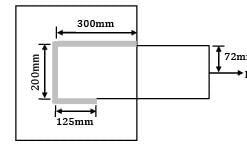


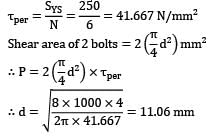
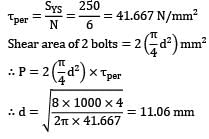

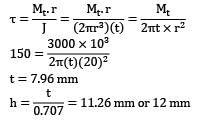
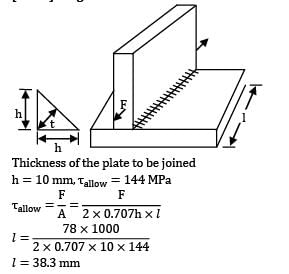
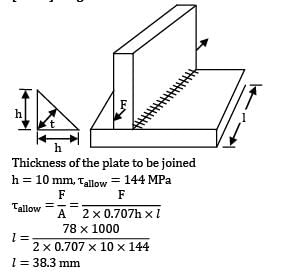
 t)
t)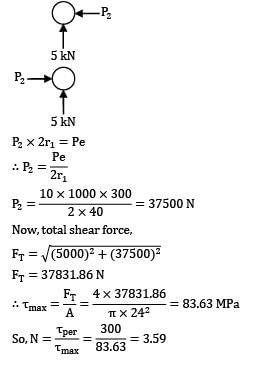
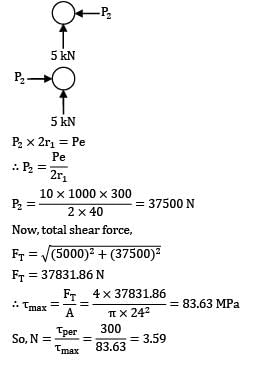
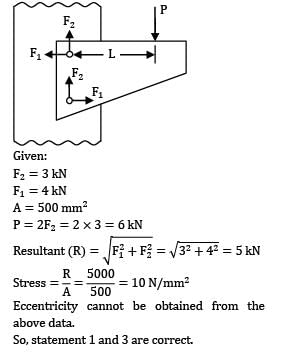
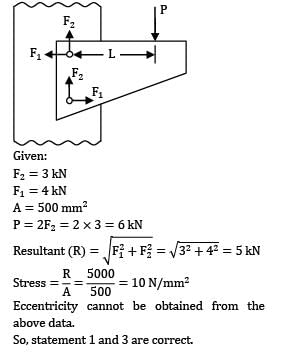
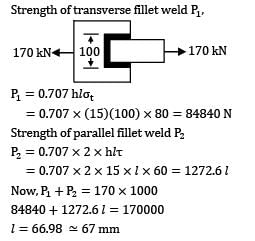
 t
t mm
mm kN, h = 25 mm
kN, h = 25 mm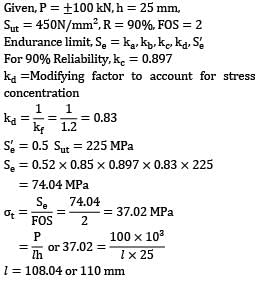
 b)
b)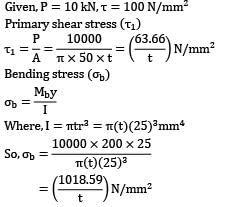
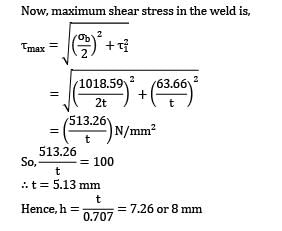
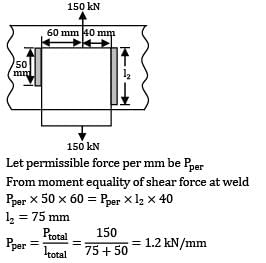
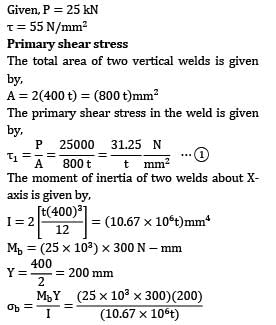
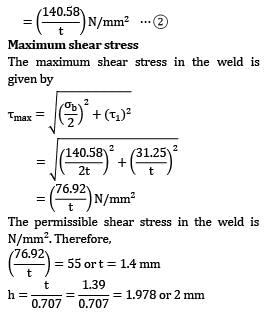
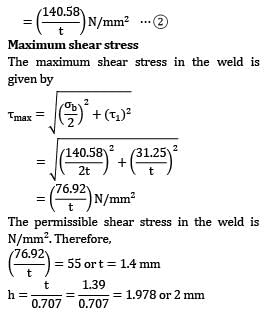
 lt
lt Total force of resistance of the welds
Total force of resistance of the welds 3 mm
3 mm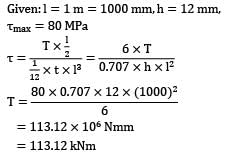

 t)max = 60 N/mm2
t)max = 60 N/mm2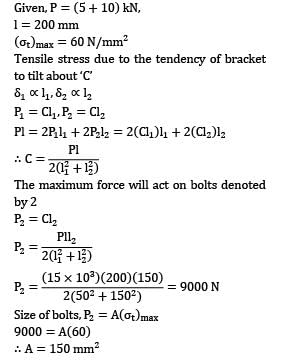
 t)max
t)max t = 70 MPa,
t = 70 MPa,  c = 100 MPa
c = 100 MPa
 t = (200 - 2 x 25)25 x 70
t = (200 - 2 x 25)25 x 70 25 x 25 x 100 x 5
25 x 25 x 100 x 5 200 x 25 x 70
200 x 25 x 70